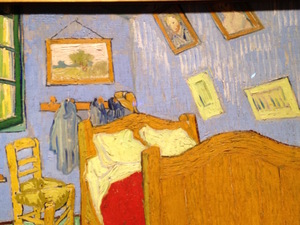Van Gogh's Room
Monday, June 15, 2020

Vincent Van Gogh, The Bedroom, 1889. Art Institute of Chicago. Detail photo Rachel Cohen.
Today there is a small glitch in the program that allows me to upload images as part of these notebook entries, and this changes how I can take you through Van Gogh's room — the square table with the blue pitcher in its bowl and the stoppered glass bottles, the open green casement window, the floor with its rough texture of green and brown, the two bright yellow straw chairs, the red cover on the bed, the row of pegs on the wall on which hang the blue work clothes and the soft-brimmed hat — all this will be in words. Perhaps that is good in its way, a space to enter more like a novel, not so much considering his space as making one of your own.
What I want to make note of are the paintings on the walls. I've chosen the one picture that I can show accordingly. If you look back at it, you can see that on the side wall there are four paintings, one clearly a portrait. And that, above the head of the bed, there is a painting of a green tree in a bit of landscape. I am interested in the way Van Gogh painted trees, and this painting of a painting of a tree gives me some clues.
First, as perhaps you know. This bedroom was of great significance to Van Gogh. It was in the first, and only, house that Van Gogh called his own, the famous "yellow house" at Arles. When he moved in, in 1888, he was exhilarated, and felt that sense of groundedness and possibility that many of us have felt in a first real room, apartment, or house of our own.
He immediately painted a set of paintings to go on the walls. That is a lovely thought to me. Here is my new house, I will paint paintings to decorate the walls, and it happens that they will all be Van Goghs. Anyway, he exhausted himself. And fell into bed for two days. And then when he got up, painted his bedroom. And was delighted with the bedroom painting. There was a flood that damaged this first painting, and he painted the same painting again twice more – a year later, at very nearly the same scale, and then shortly after that again, a small version, as a present for his mother and sister.
I have spent some time with The Bedroom at the Art Institute. But the museum also did an exhibition I did not see, months before we arrived in Chicago, bringing together the three versions of the same subject. And so there is a whole set of online materials if you are curious to make close comparisons. The Art Institute's materials, and a short article by Katie Rahn, point out that there are significant changes in the portraits on the right-hand wall.
The first, happy version of the bedroom was painted a few days before the arrival of one of Van Gogh’s most important friends and, some later came to feel, his most important enemy, Paul Gauguin. In the happiest bedroom, the portraits painted on the wall are actual portraits by Van Gogh, still in existence, of actual people Van Gogh knew, and anticipate camaraderie and artistic growth. One is of a painter-friend, the other of a soldier-friend.
By a year later, a devastating year, in which Van Gogh lost significant ground in his hopes for what his life could be, the paintings on the wall have become a self-portrait of the artist paired with one of an imaginary woman. The self-portraits resemble actual Van Gogh paintings, the imaginary women paintings don’t exist, to our knowledge. So, he has gone from painting his own real paintings, to painting paintings of his that he will not paint.
One change that goes unremarked in the museum materials is the change to the tree. In the Art Institute’s painting, the tree is green, stands on the ground, there is a blue in the background, the trunk is brown and curves and branches in a way typical of a Van Gogh tree.
While I have been working on this entry, the good people at Slabmedia have fixed the glitch. So here is a screenshot of a magnified detail of the Art Institute’s Van Gogh bedroom:

Fortunately, the Musée d’Orsay also provides the possibility of extreme magnification of their collection. Look at the tree in the next painting of his bedroom, the one he sent to his mother and sister as things began to fall apart:

It is a difficult tree. Has it been truncated? Is it growing in some wavery way? Is it phallic? Is it blowing away? Is it dawn or sunset, spring or winter. It is not what it was.
Van Gogh painted the layers of his life right on to the walls of his room. That is what each of us is doing in our confinement – you just can’t see the paint.











